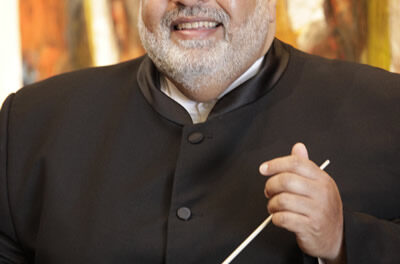The Asheville Symphony’s programming for this third Masterworks concert in Thomas Wolfe Auditorium included both standard concert fare – works by Bach and Beethoven – and a work by Bartók rarely heard in Asheville. Holding pride of place as the concert opener, Bartók’s Divertimento for String Orchestra was by far the most challenging work to absorb, and Conductor Daniel Meyer’s leadership through it was followed closely by a rapt audience. This work and Bach’s Orchestral Suite No. 2 in B Minor, S.1067, with flute soloist Lissie Okopny showcased the talents of principal players in the orchestra in the program’s first half. Beethoven’s Symphony No. 7 was the sole work after intermission, providing a rousing close to this Masterworks Concert of “3 B’s.” The concert sponsors were Mr. and Mrs. Henry W. Kramer.
I can remember a time in the Asheville Symphony’s history where the numbers in the audience were much lower and the conservative programming seemed to be driven by an effort to stem further attrition. Those worries now appear to be in the distant past. The audience has steadily grown and loyalty to the organization is now cemented under Meyer’s direction. He is a dynamic personality whose passion for music making is evident in both his willingness to program less “accessible” works and in his ebullient conducting style.
Bartók had a connection to Asheville, having spent five months at the Albemarle Inn from December, 1943, through April, 1944. His Divertimento from 1939 was composed while he was still in Europe and was commissioned by Paul Sacher, founder of the Basle Chamber Orchestra. Like a Baroque concerto grosso, it features a constant dialogue between a small quintet of string soloists and the larger string orchestra. Concertmaster Jason Posnock, principal second violinist Debra Anthony, principal violist Kara Poorbaugh, principal cellist Jacqueline Taylor, and principal bassist Vance Reese formed the small group of soloists. The audience settled in immediately, the silent stillness evidence of concentration on the sprightly opening theme in the violins, accompanied by vigorous pulsing rhythms in the lower strings. As the sonata-form movement progressed, the soloists interjected their passages, sometimes just fragments, with an air of spontaneity. From where I was seated, not all of the soloists could be heard clearly; the acoustics of the hall are partly to blame. Meyer directed the ensemble well through the many moods within this one movement, from passionate unison outbursts to whimsical exchanges. The second movement, Molto Adagio, was deliciously slow and appropriately brooding with melodies within a narrow range and a winding, changing contour. The stillness created within this movement was an exceptional moment of stasis within the entire concert and yet generated a feeling that change was on the horizon, like so many storm clouds gathering. The surprises in the third movement, Allegro assai, were the individual voices which came suddenly out of nowhere and the juxtaposition of an academic sounding fugue with a schmaltzy bit of fluff, all leading to an energized conclusion.
Next the stage was cleared of everything but 12 stands for the string players and a small harpsichord. Though the Bach Orchestral Suite No. 2 in B Minor was played on modern strings and a modern transverse flute, nods were made to historic performance practice. Violinists and violists stood around flutist Lissie Okopny with cello and bass located near the harpsichord (played by Patti Black), which was slightly amplified. With the opening Ouvertüre, the ensemble double-dotted all the dotted rhythmic figures in its slow sections, giving it that characteristic French jerkiness so prized in the 17th and 18th centuries. The fast section of this movement, which is quite long, flew by, with ample passagework for the flute occasionally doubled by the first violin. The second movement, Rondeau, featured a heavy inflection on beat 1 and several reprises of its opening material. The Sarabande was moved forward faster than I’m accustomed to hearing it, but was beautifully played. Bourrées I and II were played with a judicious use of terraced dynamics, and in the Polonaise the flute appears in a brighter register, displaying its independence by playing an obbligato to the theme in the basso continuo. The virtuosic concluding Badinerie was executed brilliantly at lightning speed, requiring the flutist to pull out all the stops through a very dense melodic line. The audience responded immediately with a standing ovation and several curtain calls.
The Beethoven Symphony No. 7, Op. 92, called the whole orchestra back to the stage. This great work, in which melodies take a back seat to overriding rhythmic forces, seemed tailor-made for this ensemble. Even in the opening Poco sostenuto slow introduction before the onset of the Vivace, Meyer kept the momentum pressed forward so that the arrival of the Vivace was not a moment of such stark contrast. The rhythmic insistency of this whole symphony is unique, never more so than in the big moments in this first movement where the entire orchestra is thundering together, fortissimo, in the same jagged rhythmic patterns. The big moments in all the movements were enormous, infused as they were with an encapsulation of the energy leading up to them. The poignant second movement Allegretto sounded less funereal than usual, again as a consequence of a brisker tempo, and its fugue, occurring at the peak of the movement, was beautifully voiced. The third movement, Presto, segued (with only a slight pause for page turns) into the final Allegro con brio, brilliantly played save for a few passages in which the brass were too loudly playing a relatively insignificant part. The energy Meyer summoned from both himself and the orchestra was extraordinary and brought members of the audience once again to their feet in waves of applause.
This performance was recorded for re-broadcast by WCQS on Tuesday, February 4 and Thursday February 6.
The ASO’s season continues with a holiday program on December 15. For details, click here.











